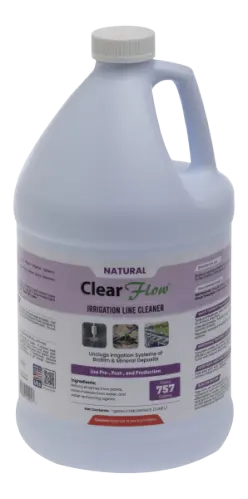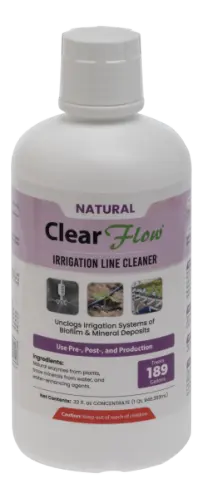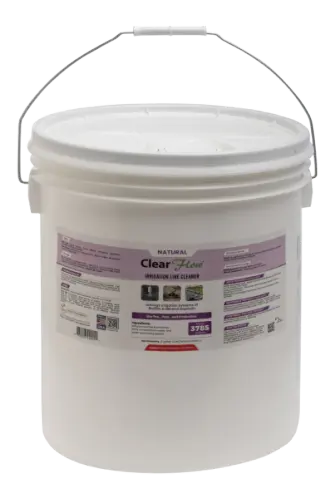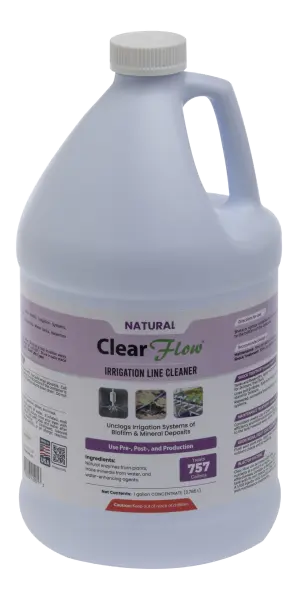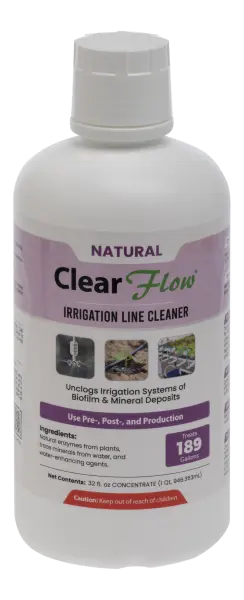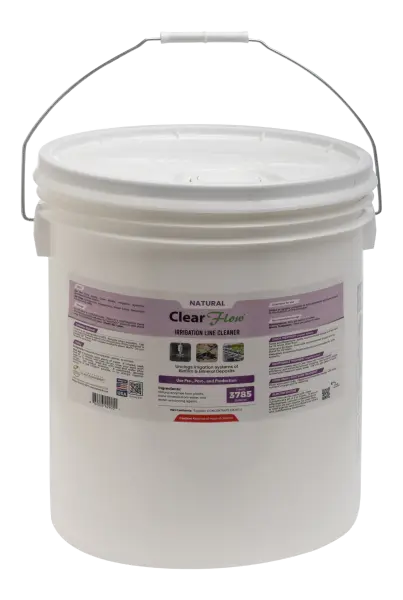Natural Enzymatic Biofilm Destroyer
Biofilm buildup can severely impact growers by clogging irrigation systems, reducing water flow, and limiting nutrient uptake, which ultimately harms plant growth. This makes effective biofilm degradation important for maintaining healthy irrigation systems and ensuring optimal plant performance.
Environmental Plant Management offers Clear Flow™, a natural, chemical-free solution specifically designed to tackle biofilm using a powerful blend of catalytic enzymes.
When growers use Clear Flow™ as a biofilm destroyer, they experience improved water flow and enhanced plant growth, leading to higher crop yields.
Clear FlowTM, a natural enzymatic solution biodegrades biofilm in irrigation systems, grow media & plant roots
What is Biofilm Degradation?
Biofilm is a slimy, often invisible layer composed of microorganisms that attach to surfaces such as irrigation lines, tanks, and plant roots. This buildup poses serious challenges for growers as it provides the ideal breeding ground for bacterial growth, which is why biofilm degradation is very important.
Biofilm degradation refers to the process of breaking down these layers to restore system efficiency. In agricultural and irrigation systems, degradation is achieved by targeting the biofilm structure to prevent clogs and keep water and nutrient delivery consistent. The ability to degrade biofilm without damaging equipment or plants is crucial for maintaining productivity.
Understanding this process is key to enhancing irrigation system performance, which is further explored in the next sections.
Why Destroying Biofilm is Essential in Irrigation Systems
Biofilm forms when microorganisms, including bacteria and fungi, create a protective layer inside irrigation systems. Over time, this layer thickens, leading to clogs in lines, emitters, and filters. Neglecting to maintain clean and clear water systems can result in the following issues:
- Pathogen Accumulation: Biofilms harbor bacteria and other pathogens such as Pythium, Phytophthora, Rhizoctonia, and Thielviopsis, which can lead to root diseases and significant crop losses. This also forces growers to combat numerous diseases with an array of fungicides
- Decreased Water Flow: The thick biofilm layer reduces water flow and compromises the efficiency of nutrient delivery, causing stress to both plants and irrigation equipment.
- Nutrient Uptake Interference: Biofilms can interfere with nutrient uptake, leading to deficiencies and reduced yields.
- Altered Soil Conditions: Biofilms can affect the pH and oxygen levels of soil or water, which can negatively impact plant growth and health.
- Increased Environmental Stress: Plants may become more susceptible to environmental stressors like drought, salinity, or temperature extremes due to biofilm presence.
If left unchecked, biofilm can cause significant crop damage and lower yields. Regularly destroying biofilm is crucial for growers, as it ensures smooth water flow, promotes healthier plants, and reduces maintenance costs.
Enzymes that Break Down the Biofilm Matrix
Biofilm-degrading enzymes are essential for breaking down biofilm, which helps keep irrigation systems running smoothly.
The different enzymes in our proprietary ingredient blend target different parts of the biofilm.
By using these specific enzymes, growers can enhance the performance of their irrigation systems and improve nutrient delivery to their crops, as demonstrated in products like Clear Flow™.
Clear Flow -
Biodegrades Biofilm in Tanks, Reservoirs, Hydroponics
- Contains no harmful or undesirable chemicals
- Safe to use Pre-Production, Production, Post-Production
- Clears Irrigation Systems, Tanks, Emitters, Roots, Grow Media, Hydroponic Channels
- No Hydrogen Peroxide, Chlorine, Acid
Biofilm Destroyer Solutions
Various methods exist for addressing biofilm buildup, ranging from mechanical cleaning to chemical treatments. However, chemical solutions often pose significant downsides, including potential toxicity to plants and the environment, as well as the risk of developing bacterial resistance over time. These issues can negatively impact plant health and the efficiency of the entire irrigation system.
In contrast, enzymatic and microbial approaches offer safer and more sustainable alternatives. These methods not only effectively target biofilm but also do so without the harmful side effects associated with chemicals.
Learn more about how our formulas work to destroy biofilm and discover the sustainable biofilm degradation benefits.
How Enzymatic Formulas Work to Destroy Biofilm
Clear Flow™ features a unique formula of catalytic enzymes that effectively eliminate biofilm without using harmful chemicals. These enzymes specifically target components within the biofilm, breaking them down into smaller pieces that are easier to manage. This process not only disrupts the structure of the biofilm but also prepares the organic material for removal.
As the enzymes break down biofilm, they help restore proper water flow in irrigation systems, ensuring that plants receive clean, high-quality irrigation. This approach allows growers to maintain healthy ecosystems, promoting strong plant growth without any negative impact on the environment.
Clear Flow™ The Effective Biofilm Destroyer
Clear Flow™ stands out as a trusted solution for growers in every production method, ensuring the delivery of high-quality irrigation water with its single-part formula that harnesses the power of catalytic enzymes. These enzymes efficiently degrade biofilm on both plant and non-plant surfaces, improving water flow and system efficiency.
By increasing water flow efficiency and reducing the need for frequent maintenance, our advanced biofilm destroyer also contributes to higher plant yields. Its high dilution rates and resource conservation make it a cost-effective option, helping growers maximize profitability while minimizing environmental impact.
Our solution effectively eliminates biofilm and helps remove green water and mineral buildup from both plant and non-plant surfaces. Its versatility makes it suitable for use in a variety of systems, including ponds, lakes, green living walls, hydroponics, and aquaponics.
Natural Ingredients for Safe Biofilm Degradation
Clear Flow™ features a powerful, enzyme-based formulation designed to effectively degrade biofilm while ensuring crop safety. Free from harmful chemicals and microbes, this solution is ideal for use across all stages of crop cultivation—pre-production, production, and post-production.
With no hydrogen peroxide, chlorine, or acids in its formulation, Clear Flow™ eliminates concerns about damaging plants. Additionally, this chemical-free solution mitigates the chances of bacterial resistance, a concern linked to many traditional biofilm treatments.
Selecting this natural alternative helps growers ensure their crops thrive while promoting sustainable practices that support both environmental and agricultural health.

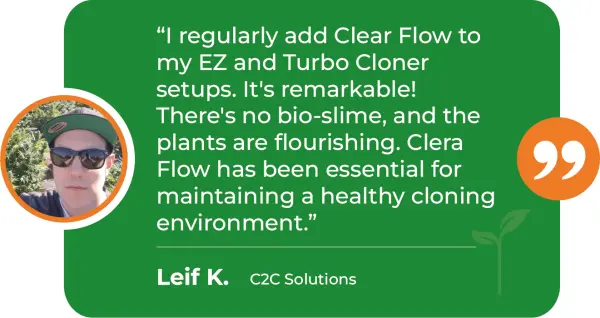
Practical Applications for Destroying Biofilm in Irrigation Systems
To ensure efficient treatment, it's crucial to agitate the enzyme-based components of Clear Flow™ before diluting it. It’s also important to agitate the diluted solution prior to application. Always maintain equal proportions to achieve the best results.
Natural ingredients within the mixture may settle at the bottom, so keeping the water circulating is vital. This agitation process not only enhances the effectiveness of the treatment but also helps distribute the ingredients evenly throughout the system, ensuring that all areas receive adequate biofilm remediation.
Applying Biofilm Degrading Enzymes in Hydroponic Systems
Follow these guidelines to effectively use our biofilm destroyer in hydroponic and aquaponic setups.
Begin by flushing your irrigation lines and emitters with water. Next, measure and apply the recommended dosage of the Clear Flow™ solution to your tanks and reservoirs. Allow the mixture to stand for 24-48 hours, as this resting period enhances enzyme activity before you flush the system again.
For optimal results, incorporate the Clear Flow™ treatment with every nutrient flush / top-off to ensure consistent biofilm management. When treating the grow media and root zones, apply the recommended dosage to hydrated plants, one hour after being watered to runoff, then flush with clear water.
Tips for Maintaining Clean Irrigation Systems
Establishing a routine maintenance schedule is essential for ensuring long-term cleanliness in your irrigation systems and effectively preventing biofilm buildup.
Incorporate a maintenance treatment with every nutrient charge; this helps maintain a balanced environment for your plants. Additionally, applying a maintenance treatment to fully hydrated plants one hour after watering will further inhibit biofilm growth, keeping your system functioning optimally. This allows the enzymes to work effectively, breaking down any residual biofilm.
Consistent application of these practices not only prolongs the life of your irrigation system but also promotes healthier plant growth by maintaining a clean and efficient growing environment.
Clear Zona Pro™ A More Powerful Alternative
For growers who need a more robust solution, Clear Zona Pro™ offers advanced biofilm degradation. While Clear Flow™ focuses on enzymatic action for breaking down biofilm, Clear Zona Pro™ goes further by also degrading organic debris on both plant and non-plant surfaces.
Contact Us to Learn More About Our Biofilm Degradation Product
Feel free to contact us today to learn more about Clear Flow™ or how to maintain clean and healthy plants and irrigation systems.
We are committed to providing in-depth information, helping you find a distributor, and guiding you through our Commercial Grower Purchasing Program. If you are interested in distributing our products, please fill out our reseller application.
At Environmental Plant Management, we strive to be your reliable partner in plant health and pest control. Our mission is to help your crops flourish and remain free from pests and biofilm buildup through customized, effective solutions designed specifically for your needs.



